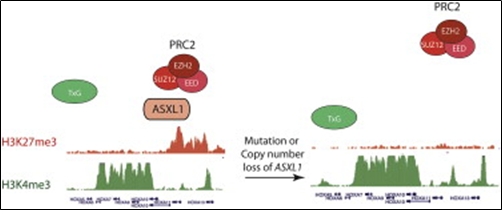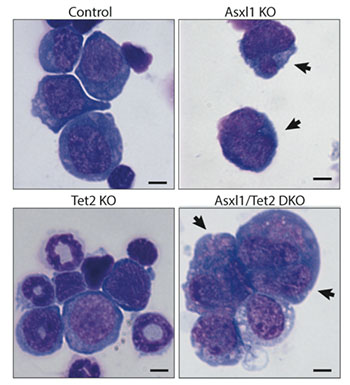


Posted December 23, 2014
Omar Abdel-Wahab, M.D., Memorial Sloan-Kettering Cancer Center
 What is the most important thing that stakeholders should know about your research progress?
What is the most important thing that stakeholders should know about your research progress?
Through generous research support from the Department of Defense Bone Marrow Failure Research Program Fiscal Year 2011 Postdoctoral Fellowship Award, we have been investigating how newly discovered mutations in the DNA of patients with Myelodysplastic Syndromes (MDS) and related bone marrow failure disorders actually give rise to impaired blood production. We have determined that mutations in the gene ASXL1, which occur in 20% to 30% of MDS patients and are also common in patients with aplastic anemia (AA), impair the function of an enzymatic complex, which normally makes specific modifications to the histone proteins that DNA is wrapped around (see Figure 1). This results in a change in gene expression in a manner that impairs the normal production of mature blood cells from hematopoietic stem cells-a problem that is characteristic of MDS. Our hope is to now utilize these insights to develop new therapeutic approaches to promote normal blood production in MDS and AA patients by targeting this impaired enzymatic machinery.

Figure 1: ASXL1 mutations or loss impair the ability of the Polycomb Repressive Complex 2 (PRC2) to place its enzymatic mark on histone proteins. Above is a graphic illustrating that in the presence of ASXL1, the PRC2 enzymatic complex is able to place and maintain methylation of histones (left). However with Asxl1 mutation or deletion, the PRC2 complex loses the ability to maintain this enzymatic function.
How did you arrive at this information or approach?
Our approach to understanding mutations in the DNA of MDS patients has been to generate genetically engineered mice that harbor the same mutations in DNA that MDS patients have. This effort has resulted in the generation of multiple brand new mouse models of MDS. For instance, we generated mice with deletion of the gene Asxl1 as well as mice with combined deletion of Asxl1 and Tet2 (see Figure 2). These mice develop a form of MDS later in life that mimics the human disease both in genetic alterations and in disease development. These have become precious tools for ongoing and future bone marrow failure research, and we, therefore, have been making these mice freely available to the international research community through Jackson Laboratories.

Figure 2: Dysplastic hematopoietic cells from mice with knockout (KO) of Asxl1 and Asxl1 plus Tet2. Our approach to understanding how alterations in the DNA of bone marrow failure patients actually result in disease has been to generate genetically engineered mouse models that mimic the human genetic alterations. Some of these mouse models develop bone marrow failure similar to what is seen in patients. Above are blood cells from the bone marrow of mice with KO of the gene Asxl1 or combined KO of Asxl1 and Tet2-mutations commonly found in MDS and aplastic anemia (AA). These mice develop low blood counts and dysplastic blood cells similar to patients.
What is the next step to bringing your research closer to helping bone marrow failure patients?
Our efforts to date have been focused on understanding how mutations in MDS patients cause MDS, but the next critical step in our effort will be to use this information to improve the therapy of MDS patients. To do this, we are performing a number of studies using libraries of drugs and genetic tools to identify new approaches to "change" an MDS cell into a more normal, healthy functioning hematopoietic cell.
Is there any other information that you think readers should know about your work?
Our research very much focuses on understanding and targeting specific genetic alterations that occur commonly in patients with bone marrow failure. Our hope is that this approach will result in targeted treatments for bone marrow failure patients that will limit toxicity to the normal cells of the body.
Publications:
Inoue D, Kitaura J, Togami K, et al. 2013. Myelodysplastic syndromes are induced by histone methylation-altering Asxl1 mutations. J Clin Invest 123(11):4627-4640.
Abdel-Wahab O, Adli M, LaFave LM, et al. 2012. ASXL1 mutations promote myeloid transformation through loss of PRC2-mediated gene repression. Cancer Cell 22(2):180-193.














